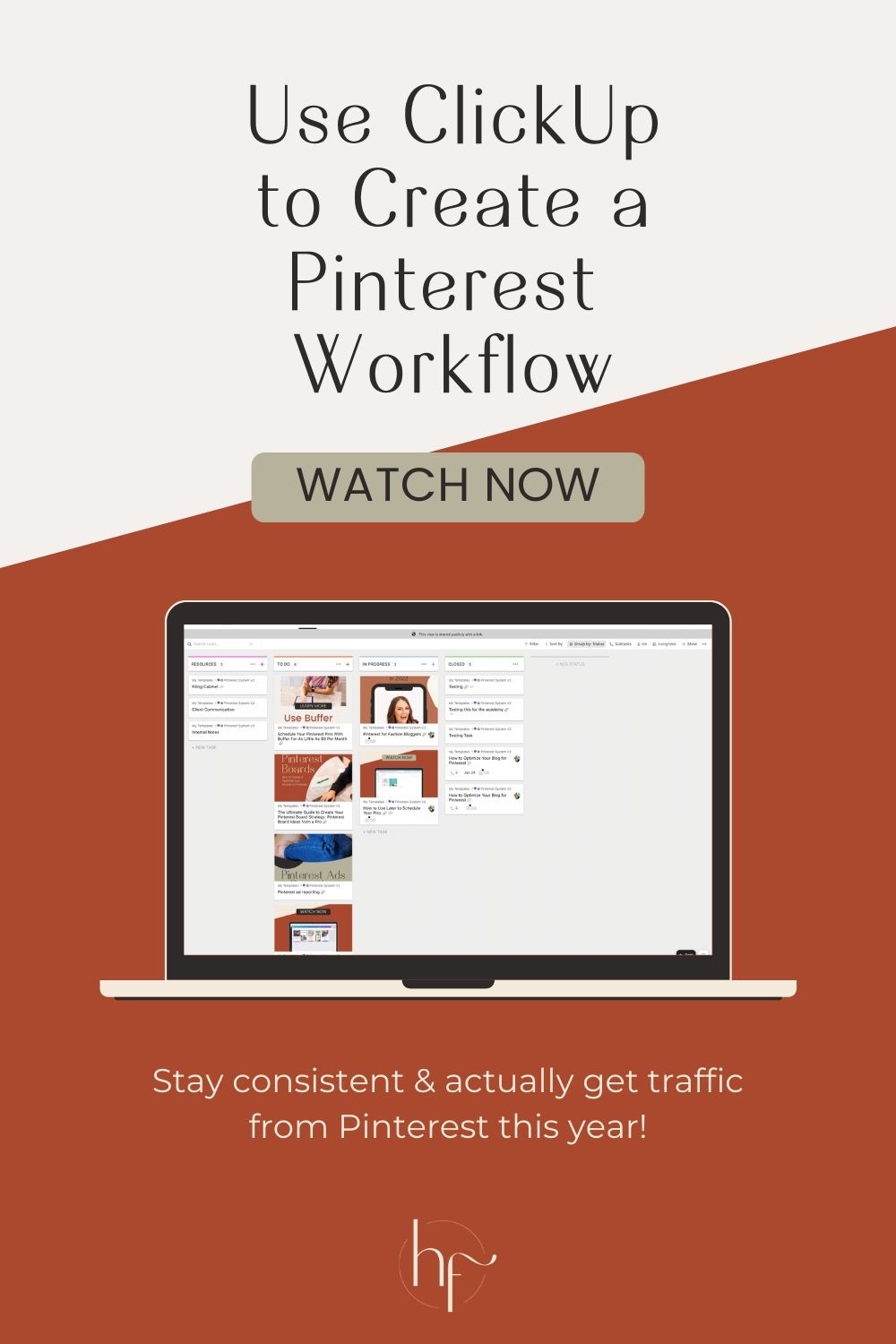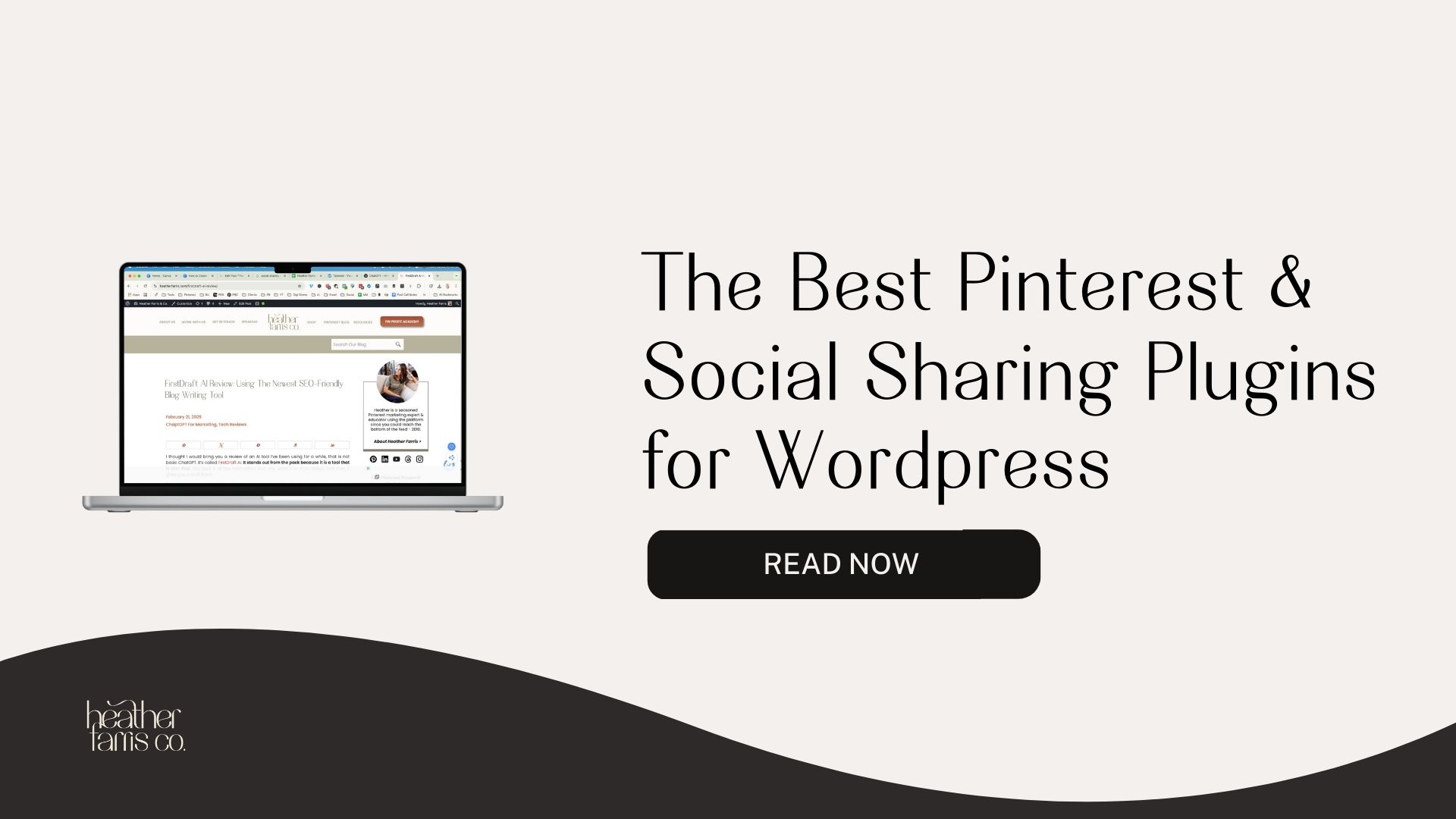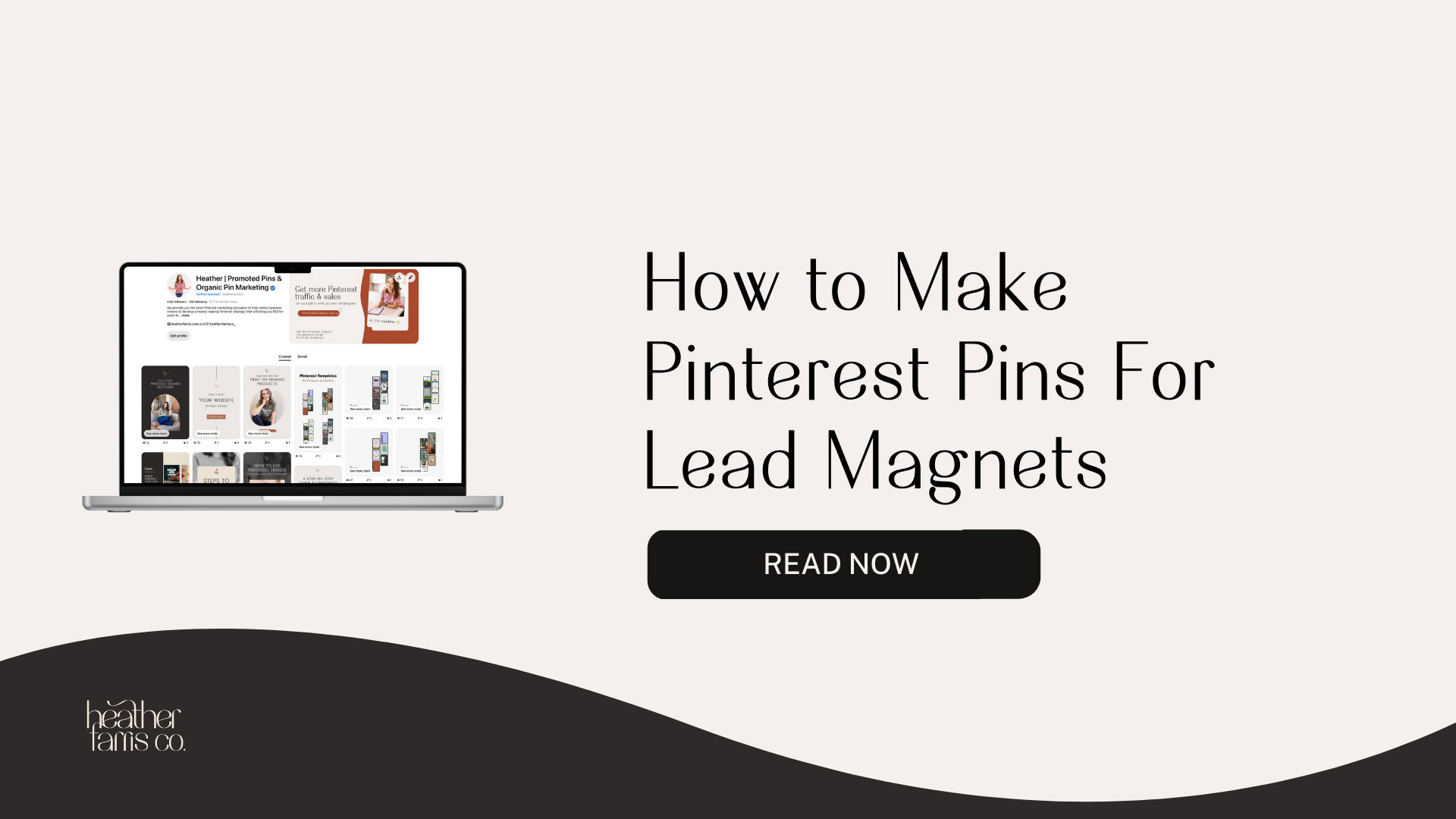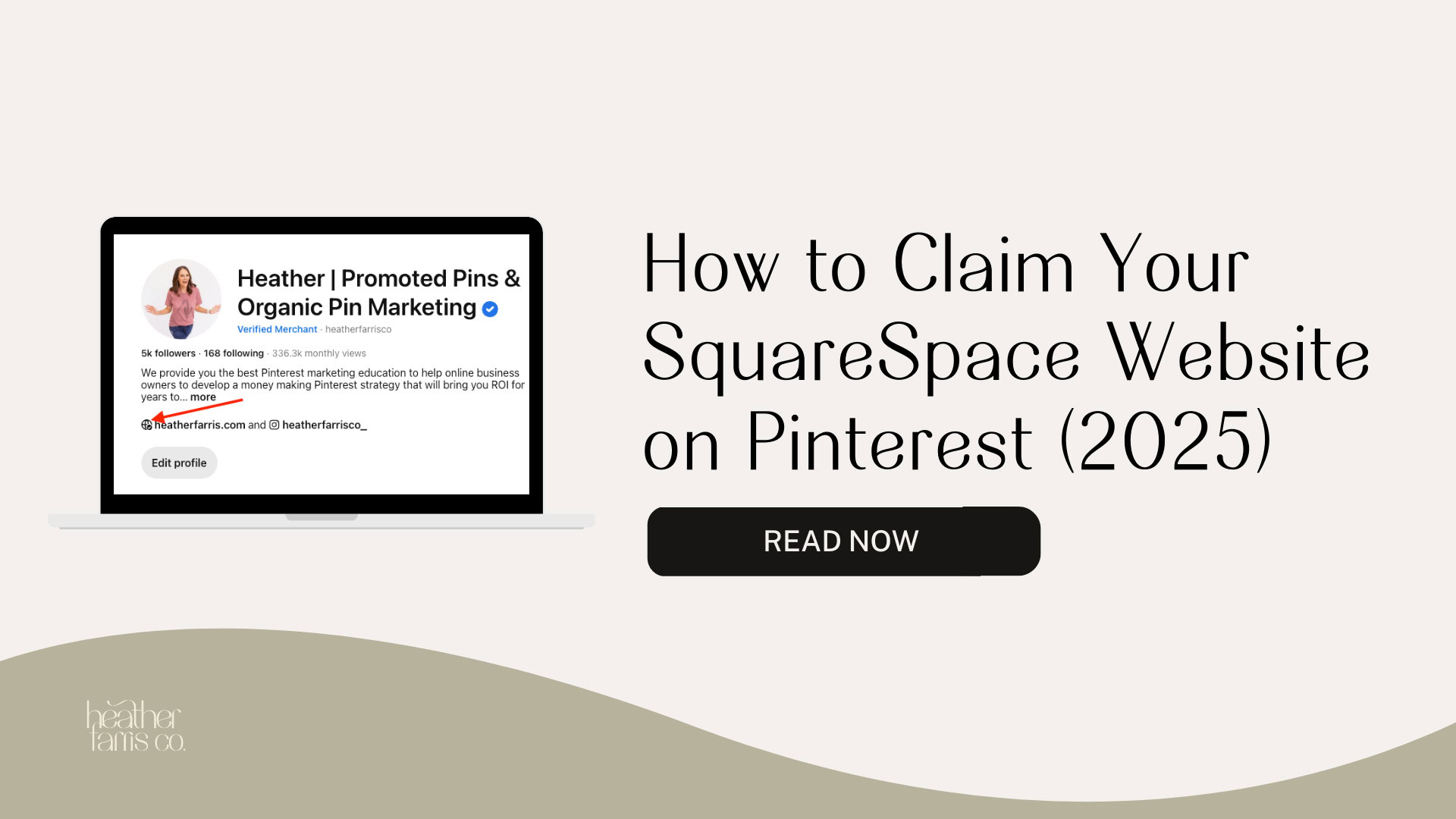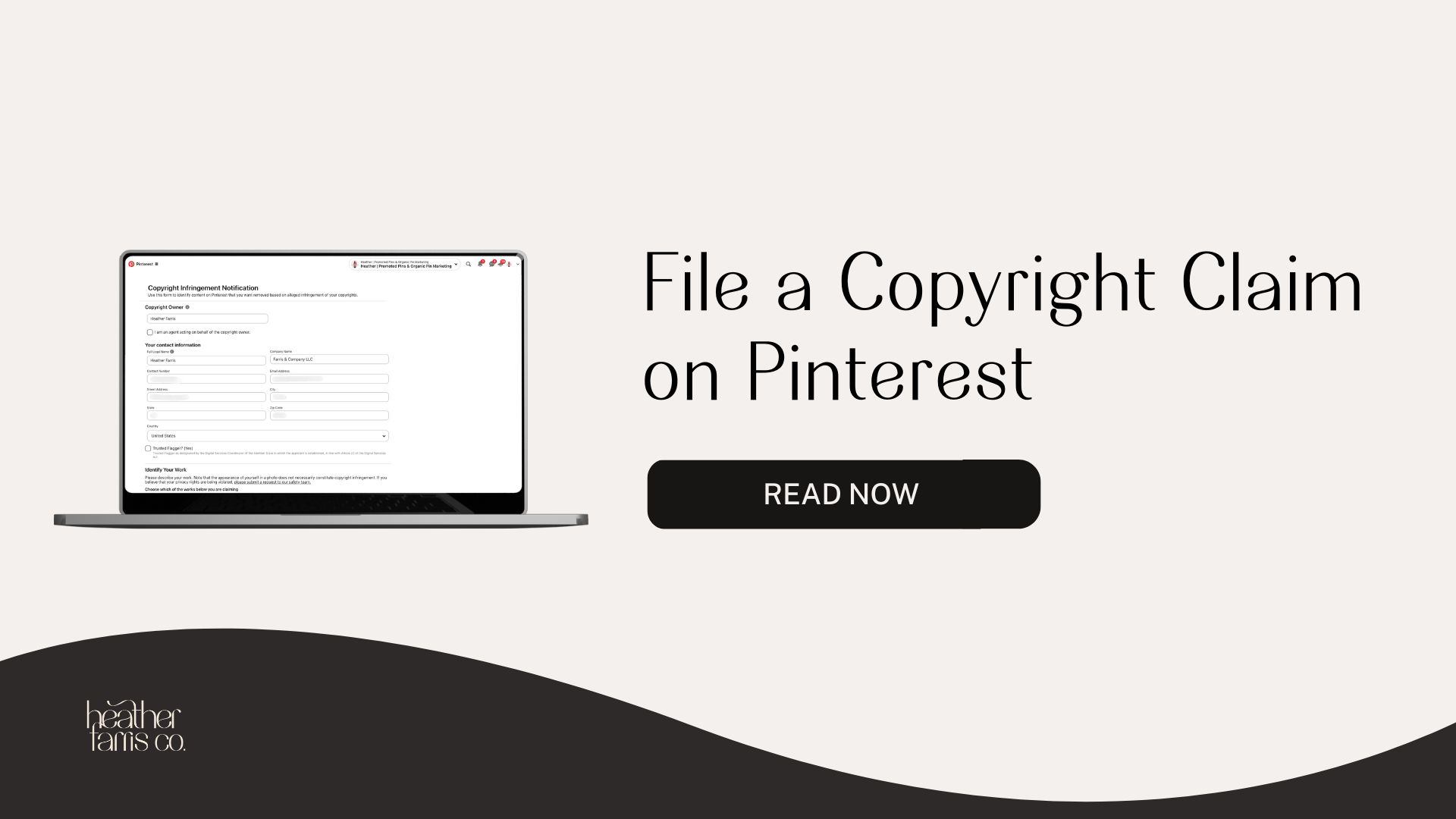Heather is a seasoned
Pinterest marketing expert & educator using the platform since you could reach the bottom of the feed - 2010.
About Heather Farris >
How to Manage Your Pinterest Strategy in ClickUp
March 17, 2022
Are you looking for a way to better track and implement your Pinterest marketing strategy in 2022? Maybe you just need a better system to tell you when to create pins and what to create pins for. My framework system, the Pinterest System, will help you do just that.
In this particular tutorial, I will walk you through how to use my Pinterest System inside of my favorite tool – ClickUp (my work wife). We are marrying the Pinterest System spreadsheet together with the Pinterest System ClickUp List, a simple Pinterest strategy in ClickUp.
I’ll show you exactly how you can manage, implement, track and maintain your Pinterest strategy inside this system. So let’s hop right on into the good stuff.
My Pinterest Strategy in ClickUp
This is the Pinterest System inside of ClickUp. I’ve created the second version of this, so this is the more simplified version. Follow along with the video tutorial so you can best see how you can setup your ClickUp if you don’t yet have the Pinterest System.
Right off the bat, I want you to take note of what’s across the top and the statuses in the system itself.
RELATED: How to Create a Blogging Workflow Using Clickup
Board view
We have a board view that I have pinned for myself.
Content Hub
I always pin the spreadsheet, which is my original Pinterest System inside our ClickUp Pinterest Systems. That way, we can still use this because we use them for analytics, the board, and keyword research.
Calendar view
And then, I created a calendar view. So if we need to look at a calendar view, we have it there.
Pinterest Strategy write-up
The last and final thing that you get when you’re an Academy member is our Pinterest Strategy write-up, which is pinned to all of our templates for the system. This write-up is an outline of the Pinterest strategy.
That way, if you ever bring someone to help you inside of your Pinterest strategy, they can see exactly how to do things and in what order they can find your templates and everything.
So I try to make this as simple as possible from this template point of view.
RELATED: 7 Content Marketing Tools to Use in 2021
Statuses
Our statuses in this template are:
- Resources
- To do
- In progress
- Closed
Resources
The resources or the file cabinet for this Pinterest System are things that you need on a recurring basis inside your Pinterest strategies. Things like specific templates that you use or a place where you keep all your keyword research. In this, we also have internal notes and client communication.
Client communication
If you were to use this for yourself and with a client, you can actually communicate with your clients inside of ClickUp through email without ever having to leave Click up. You can see the entire email thread in this one communication card. I actually love this feature, and we do this for all of our clients in the agency.
RELATED: Using ClickUp for Client Management
Internal notes
When we are managing our clients, anything that is internal that we would want to keep notes on or communicate back and forth, we have one place for that as well. This also ensures that our external and internal communication don’t get their wires crossed, and clients aren’t seeing any communication that they shouldn’t see. Everything that should be in-house, we’re keeping it in-house.
To Do
To start using this, you’re going to need to populate your content in the ‘To Do’ tab or the ‘To Do’ status. You can see that I’ve gone ahead and created a bunch of pins, and I’ve put those pins in the To Do tab. Then I’ve moved a few of those items to the ‘In Progress’ tab.
So, the To Do List has things that need to be done. So I will create the pins in my To Do list and then move them to In progress. Then I will write pin descriptions, titles, and anything in addition to what I need here.
Often I will use a very similar text overlay to my title, but not all the time. Maybe only 30% of the time or so. So in this To Do section, you can go ahead and create your pins, write your pin titles and descriptions and then move them to In Progress when you’re ready to schedule them.
RELATED: 10 Canva Hacks to Save You Time When Making Pinterest Pins
In Progress
When a pin is In Progress, that means it has yet to be scheduled, and we need to get it into the queue.
Scheduled
I left out this status here, but it is in our version one Academy Pinterest System. The status ‘Scheduled’ means we have put it in the schedule, and it has a due date. That’s when you can look at the calendar view. However, you can still look at this calendar view for content that’s coming up soon that you’ve already done.
So you will see that once I scheduled them and they had a recurring due date like this one right here for 2024.
**If any of these things don’t mesh up with how you prefer to work, like the statuses, you can always edit them. You can also make checklists and templates and set up simple automation to add that checklist to your task. Anytime you add something in here, it will automatically add that checklist to the task.
RELATED: I Tested Pinterest Approved Schedulers So You Don’t Have To
Setting up automation
Let us go in and click and ‘Create Simple Automation’. Here when the status changes from ‘Any’ to ‘Active’ To Do, we are going to apply a template. We can come in here and apply any of these tasks templates.
Say we wanted to apply the ‘Social’ template here. This isn’t going to match up to Pinterest, but I just want you to see what this looks like. We also want to change the assignee, and we want to add ourselves. Then we’re going to click Save, and that automation is toggled on. So you have one active automation now.
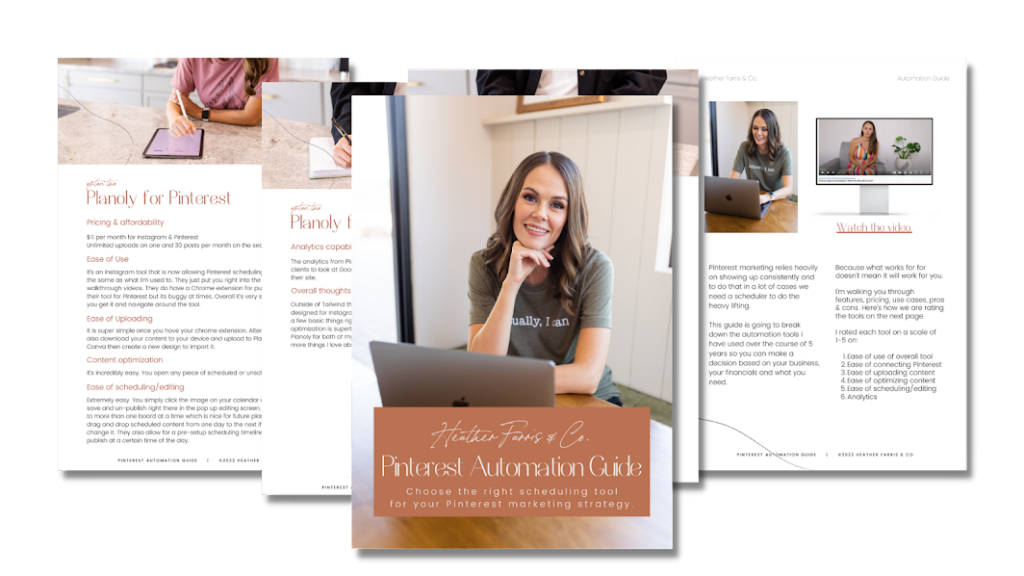
So now, anytime we have anything added to our ‘To do’ column, we will have the checklist automatically added with those five items that are in that templated item, that checklist.
I’m actually going to toggle that off because I don’t want to save this into the automation or into this template for the academy. Still, I just wanted you to see that that is a possibility there.
Creating a timeline
Now in the next phase, once we have created everything that we need to create for the pins and we’re ready to schedule, we really need to move into creating a timeline. That’s what this whole system, the whole strategy inside of ClickUp, is for.
It’s for you to consistently create pins for your content and never lose sight of that piece of content where you create it; you pin it once and never see it or share it ever again. That is exactly what we are trying to get away from. We want to be strategic in our content sharing and the timeliness of when it gets shared.
So I want you to think about this for yourself. Take a pencil and a piece of paper and write this down. If you have a lot of evergreen content, you may not be creating pins for that content as often. Maybe you only create one pin for it per month. Perhaps you only create one pin for it every other month. I’m going to leave that timeline up to you because that doesn’t matter as much as being consistent on the platform.
RELATED: Manual Pinning Strategy: How to Schedule Your Pins for Free on Pinterest
Evergreen Content
If you have a large bank of content as I do, you don’t necessarily need to create pins for it every week or every month. That’s just overkill. But being consistent and sharing a wide range of content is beneficial.
However, let’s switch gears to evergreen content. I have this recurring task that says 1/28/2024. I did not mean to set it out that far when I set this up initially. However, we were pretending like this is a piece of evergreen content.
So let’s pretend that this is a piece of evergreen content for Easter this year, and I need to start getting pins in the queue for Easter at the end of January. So right now, I’m making pins for this. Now you have a couple of options here:
- You can make one pin and have it recur every week until Easter, and then you change your recurring due date to be next year.
- You can go ahead and make a batch of pins and schedule them. Pin one goes week one, pin two goes week two, and so on. Then you make this recur next year, and you don’t have to look or worry about this task again.
RELATED: Boost Your Holiday Traffic With a Solid Pinterest Marketing Strategy
Scheduling Consistently
The great part about using a scheduling tool like Planoly or Tailwind is that you can actually pre-schedule that content. You can do this with Canva as well, and I believe so with Later, where you can schedule it in like a campaign or smart loop where it will actually turn on and turn itself off. I’m going to leave this scheduling strategy up to you.
This whole process is just to make sure that you’re pinning consistently up to the holiday in advance and you’re not going beyond the holiday. So let’s talk about studying due dates. For the evergreen content, you get to choose if you want it to recur every four weeks or if you want it to recur monthly on the same day each month. You get to set up your due date.
However, you will probably want it to recur yearly for more season-based content. And when that status is closed, you have a couple of options here. You can have it create a new task for you, and then you can choose what gets pulled into the new task.
RELATED: How to Use Later to Schedule Your Pinterest Pins
Recurring Tasks for Pinning
Typically, this is what I will do. I’ll have it create a new task, and I will have it remove the attachments, so the old pins from last year don’t actually come back into this year’s task. I need to create all new images once again. However I will keep my description, which includes my title and my description for the pin. That way, I know what I used last year, and I can use that as a foundation this year. And then I’ll click save.
Then I want it to update status to ‘To Do’. So I’m actually going to set this to be a shorter timeline. That way, you can actually see this in real-time, and it doesn’t have a due date of next year. So we’re going to say this is going to be due today. When I close this out, it’s going to recur again for a month from now.
We’re going to pretend it’s going to be a year. So I’m going to go ahead and move this out, and then I’m going to come in, and I’m going to mark this as done.
I created all these pins. I scheduled all these pins, and now I need this task to recur again but later. So it’s recurring again, but it’s going to recur on February 24th.
I want you to set up your recurring due date according to when the holiday takes place, minus 30 to 90 days. So you want to back up your time frame to be 30 to 90 days in advance of the holiday.
Final thoughts managing your Pinterest strategy in ClickUp
These are the basics of using your ClickUp Pinterest System to maintain and stay on top of your consistent content creation on Pinterest.
Now you’ve seen the inner workings of the Pinterest System version 2022. You have learned:
- How you can use it in your own business to track, implement and manage your Pinterest marketing strategy.
- What content to create and when to create it.
- What description do you use?
- Track your titles, and your images
If you want this exact template and don’t want to rebuild it, I’m offering it to you inside the Pin Profit Academy, my flagship membership offer. I have a whole Pinterest course and a whole ClickUp course in there. There are resources in the Academy for you, including today’s ClickUp tutorial and this list. So if you want this template, you can join Pin Profit Academy and grab it today.
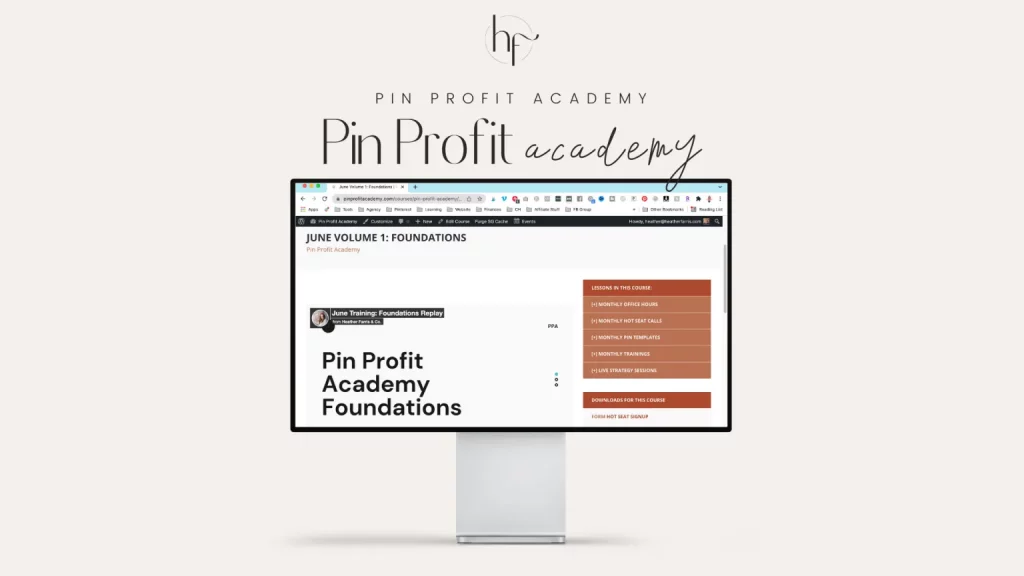
Now, if you don’t want to do that, that’s OK. You can recreate it on your own. If you want more Pinterest marketing tutorials, workflows, strategy, head right on over here and watch my Pinterest Marketing playlist.
That’s it for this week. I’ll see you next time.
Pin It For Later
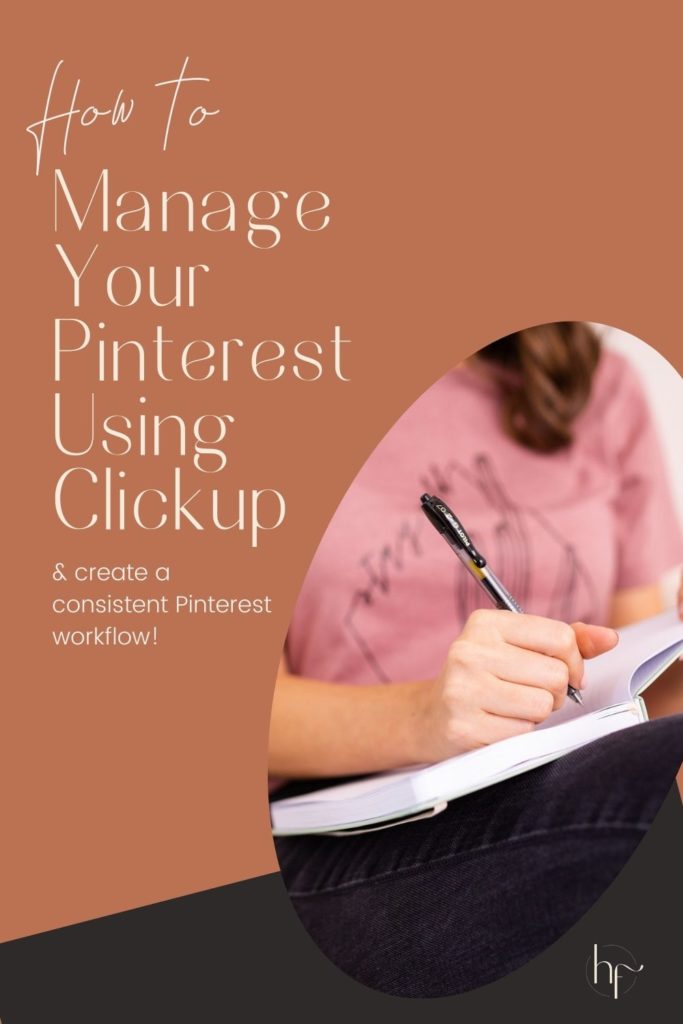
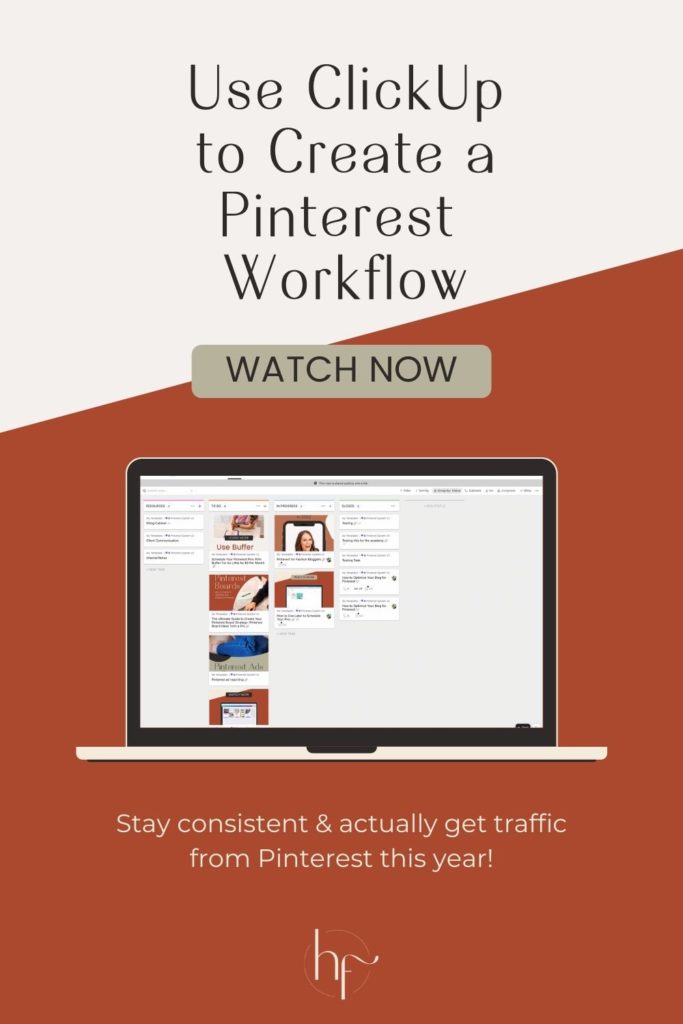
Heather Farris went to school for accounting and worked for years in banking and finance. After finding all of that entirely too boring she started her first blog in her basement in August of 2016. She has started 3 blogs in the marketing, motherhood and travel niches and used Pinterest to grow them all. She quickly became the go-to Pinterest strategist in her peer circles and has been implementing strategies, driving traffic and sales through organic and paid tactics for her clients. On this blog and her YouTube channel, as a renowned Pinterest marketing expert, she educates the public about clear and transparent marketing strategies to help them to grow on Pinterest and in other places online as a renowned Pinterest marketing expert.

